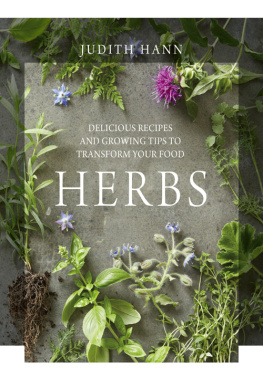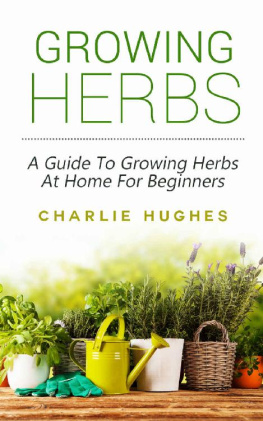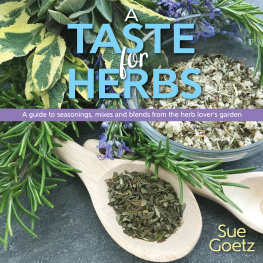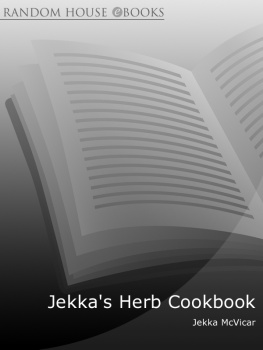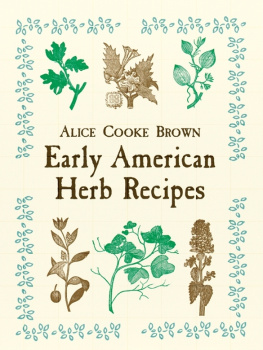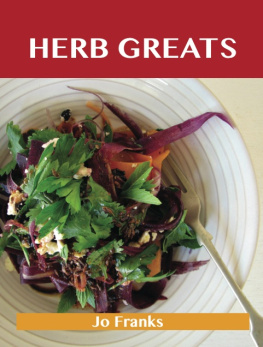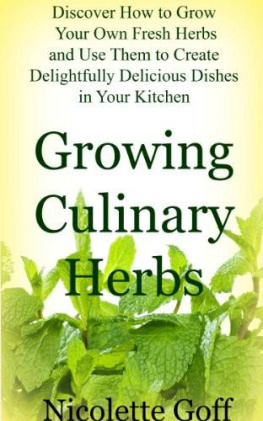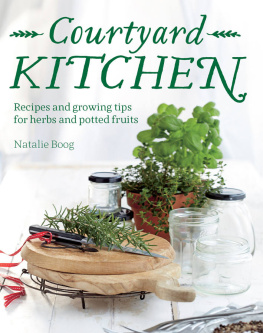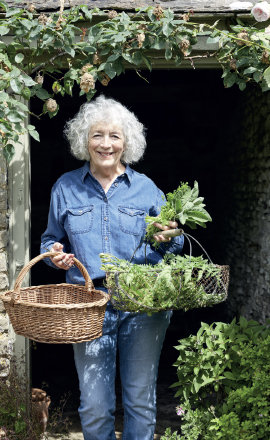HERBS
JUDITH HANN
DELICIOUS RECIPES
AND GROWING TIPS TO
TRANSFORM YOUR FOOD
HERBS
CONTENTS
FOREWORD
MY LIFE WITH HERBS
Herbs have taken over my life. They have been catalysts in the kitchen, liberating my cooking by encouraging me to be more creative. And they have also helped me to become a serious plants woman, using the different shades of green, the texture and shape of the leaves, their intoxicating aroma and their glorious flowers to transform the look of my garden. When I harvest these beautiful herbs every day, they soon transform the look and the taste of my food too.
I first realized their benefits when I used a small range of herbs, grown in pots at my London home. But when we decided to move to the country, I looked for the perfect opportunity to grow herbs on a larger scale. We found a small farm in the Cotswolds with decaying buildings surrounded by neglected, jungly land. But near the farmhouse was a sheltered walled area, with poor, free-draining soil, once used to raise pigs perfect for cultivating Mediterranean herbs like rosemary, thyme and oregano. An added bonus was that there were shaded corners where the soil could be improved for more demanding herbs.
Cultivating this derelict pig yard, then growing, harvesting and cooking every culinary herb I could track down, has provided me with plants that have elevated my cooking to a new level. It has been exciting and inspiring.
I drew the plan (pictured opposite) for my herb garden over 20 years ago, before any herbs were planted. It followed months spent reading every book on herbs I could find in a London library, as well as visiting many famous gardens. At one point my impatient husband said: It is time to stop reading and start digging. And Ive never looked back.
The tumbledown pig yard had the remains of Cotswold stone walls. After they had been rebuilt, they provided shelter for the herb plants, trapped their wonderful scents and also provided wall space for figs, grapes, roses and morello cherries. We made a small central pond to house frogs to eat the slugs which eat the herbs. There was enough ground around this pond to have four formal beds, with an area to one side for annual salad leaves and a pudding bed where I could grow sweet cicely, angelica, lavender and other herbs used in desserts.
Now I am surprised and delighted by how my enthusiasm is inspiring other people and to find that herbs are improving their lives, too. In particular, I get so much pleasure when children become interested. I gave a selection of herb plants to two local village primary schools, for children to use in cookery lessons and to attract bees and butterflies. And my two young granddaughters have been helping me plant annual seeds since they were aged two and four. Because of feeling so involved, they enjoy collecting different herbs, leaves and flowers and making beautiful mixed salads with them, which they tuck into with the rest of the family.
Our younger son, who had leukaemia as a teenager, persuaded me to start herb courses, to raise money for research into the disease. I teach people from gardening clubs, herb groups and garden training courses, as well as enthusiasts who just want to spend a day learning how to grow and cook good food. The response has been fantastic. People now travel from other parts of the world to join a course, some rip out their garden plants and replace them with dozens of herbs, others write enthusiastic magazine articles or blogs about my garden, or send me rare herb plants through the post. I have even had herb recipes named after me, including a cupcake made with sweet cicely! It has become obvious that herbs inspire passionate interest.

All this is hard work and means summer holidays are impossible. But during a winter break in Thailand, the hotel chef approached me and said: Please help us. I know you are a herb expert. he had recognized me from TV, Googled me and discovered my herb courses (Hanns Herbs). It became a working holiday, teaching the staff the best herbs to grow in the hotels new garden. So herbs have not only taken over my life, they are taking over my world.
COOKING WITH HERBS
Nothing transforms food as much as herbs. They bring depths of flavour to other ingredients. As we move away from rich, salty recipes, they are used increasingly to enhance the taste of food. And as well as tasting wonderful, they smell and look enticing and bring colour and texture to the plate. So when you use these gods of the kitchen, you cook with all your senses.
Supermarket sales of herbs are increasing, but the range available is small, they are expensive and, even when chemicals are used to prolong shelf life, they soon go stale and yellow. By growing your own herbs, in pots or in the garden, you can make any recipe without worrying whats in stock in your local shop. You can pick your herbs just before cooking, using precisely the amount you need, knowing this freshness brings the optimum flavour.
The frustration cooks can feel when they cant buy the herbs they need for a recipe was shown when a man I had never seen in my life turned up unannounced on my doorstep one morning, emerging from a car full of children and suitcases. He was on the way to Cornwall and had ordered some lobsters to be delivered to him there for a special recipe that needed chervil. But he could not find it anywhere. Finally, a local greengrocer, who knew my passion for herbs, pointed him in my direction. To reward his persistent enthusiasm I gave him a huge bag of chervil as a holiday present, just as I give away cut herbs and plants to friends, neighbours and to chefs when we eat out locally in pubs and restaurants where they really care about good food.
Many of my favourite herbs are hard to find in shops, but are easy to grow in the garden. Herbs like chervil, lovage, sorrel and oregano are rarely stocked, but they thrive year after year in my herb garden and are used in dozens of my best recipes, like Guinea Fowl with Lovage and Lime (see ).
The memorable flavour of herbs like these has helped to change the culinary code that insisted certain herbs always went with particular ingredients for example, rosemary or mint with lamb and parsley with fish. Now people experiment. As my recipes show, I use rosemary with orchard fruits, like pears, and lamb with lavender. Mint is as likely to be used in desserts as meat dishes and parsley at its best is made into pesto or fresh sauces.
Herbs build up layers of flavour, with hard herbs like bay, thyme and rosemary used for long cooking, infusing a dish with their characteristic, earthy tastes. Soft herbs like basil, coriander/cilantro, parsley or chervil are added at the end of cooking, almost like a seasoning. They can be scattered over a dish, mixed into a sauce, or added to lightly dressed salad leaves. Many of them, like chervil, have elegant leaves which look perfect as a decoration. When I am chopping these soft herbs, I do it at the last minute so the juices do not dry up and the herbs do not lose their impact on our taste buds. I use a very sharp knife to avoid bruising, so the juices are retained inside the herb leaves, achieving taste, aroma and beauty all on one plate.
Next page
